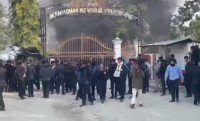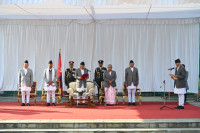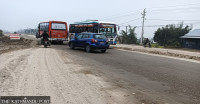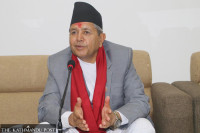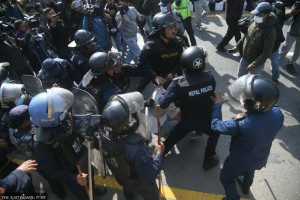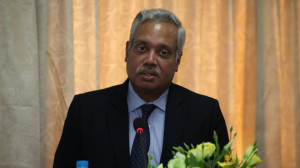National
FNJ calls for high-level probe into journalist Suresh Rajak’s death
FNJ revealed that 38 journalists have been killed in Nepal since 1999, including two in 2024.
Post Report
The Federation of Nepali Journalists (FNJ) has demanded the formation of a high-level investigation committee to probe the suspicious death of journalist Suresh Rajak during a pro-monarchy rally on March 28.
Immediately after the suspicious death of Rajak, the federation had formed a seven-member committee led by FNJ Vice-president Umid Prasad Bagchand.
The report submitted by the panel has concluded that a thorough investigation is essential to find out the truth, citing several unanswered questions and circumstantial inconsistencies surrounding Rajak’s death.
Rajak was found dead inside a building at Tinkune which was burnt during the protest by pro-monarchy forces organised under the banner of Unified Movement to Reinstate Hindu Monarchy led by Nabaraj Subedi.
The report emphasised that individuals suspected of involvement in Rajak’s killing should be formally named as defendants in a criminal complaint for homicide.
The report has raised some questions as to why Rajak remained in the burning room when others escaped. The report has suggested identifying the persons who were present there until the last moments and who were those filming the scene of the room until the last. It also points out the absence of his camera, damage to one of his two mobile phones, and raises the possibility of a targeted attack by demonstrators being angered with him for filming the protests up close.
“It must be probed whether the assailants seized his equipment and prevented him from escaping,” the report states. “These critical unanswered questions demand immediate and impartial investigation.”
The FNJ also expressed alarm over increasing hostility towards journalists, noting that Rajak and others may have been targeted for not supporting the royalist cause. The report accuses pro-monarchy demonstrators of systematically attacking mainstream media personnel, especially during the protest in Tinkune, Kathmandu.
After resorting to vandalism and arson in public as well as private buildings and vehicles and other properties around Tinkune, the protesters had attacked at the offices of Herbs Production and Processing company at Jadibuti, Kantipur Television, the Annapurna Media Network, CPN (Unified Socialist), and Bhatbhateni Supermarket, among others.
Also a youth Sabin Maharjan from Kirtipur was shot dead during the same protest.
Citing a broader trend, the FNJ revealed that 38 journalists have been killed in Nepal since 1999, including two in the past one year—Suresh Rajak in Kathmandu and Suresh Bhul in Kailali. The federation also recorded 73 press freedom violations between April 2024 and April 2025, affecting 151 journalists and five media outlets.
The report criticises both the government and media houses for failing to provide physical protection or insurance for journalists working under hazardous conditions. It further warns that the rapid evolution of digital media has added new threats, including online harassment and misinformation campaigns that incite hostility against reporters.
The FNJ called for urgent policy and legal reforms to ensure journalist safety and press freedom in an increasingly volatile media landscape.




 15.12°C Kathmandu
15.12°C Kathmandu
